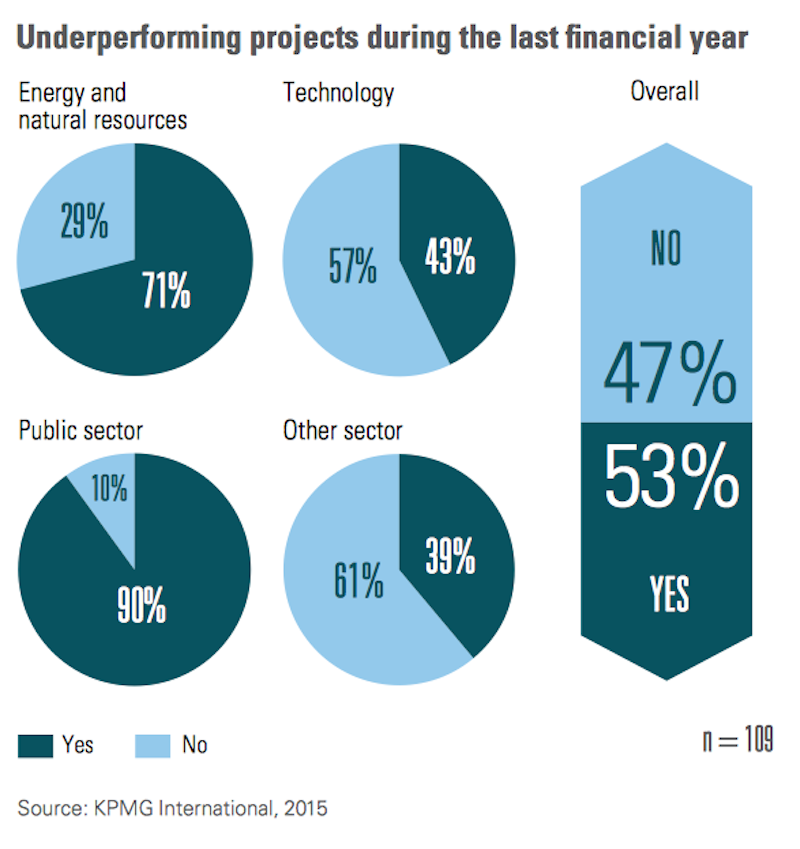Despite their planning and risk management efforts, owners are still finding that a sizable percentage of their projects are either failing or aren’t coming in anywhere near on time or on budget.
More than half—53%—of owners say they suffered one or more underperforming projects in the previous year, a number that rises to 61% for larger organizations, according to KPMG International’s ninth annual Global Construction Survey 2015, based on interviews with 109 senior leaders from private and public organizations around the world that conduct construction activity.
Only 31% of respondents’ projects over the past three years came in within 10% of their budgeted cost. And only one quarter of projects over that period came in within 10% of their original deadlines.
The owners imply that these failures, delays, and overruns are less the result of poor project oversight than of talent shortages and the lack of integration of project management information systems into these companies’ accounting and procurement software programs.

Most owners polled assert that their companies use formal screening, prioritizing, and approval processes for projects, including financial and risk analysis (84%). More than 80% of respondents state that the majority of their capital projects are planned. Thirty percent of respondents use a design-bid-build project delivery strategy, while 32% use engineer-procure-construct.
“All potential projects should be systematically identified, classified, screened, prioritized, evaluated and selected,” writes Jeff Shaw, Director-KPMG in South Africa. “This process must be supported by an appropriate budget allocation and monitoring process. Throughout the capital allocation process, alignment between strategic objectives and the capital project portfolio must be tested.”
The report notes, however, that owners are challenged finding qualified project management personnel. Forty-five percent of respondents say they struggle to attract qualified craft labor, planners and project management professionals.
While 64% of respondents believe their management controls are either “optimized” or “monitored,” nearly one-third concede that their controls are “standardized,” with no testing or reporting or reporting to management and only limited staff training.
Most construction companies rely heavily on software to manage projects. Fifty-five percent of respondents say they are “satisfied” or “mostly satisfied” about the return on investment from project management tools and training. And 73% say they are confident about the accuracy and timeliness of reports they receive from managers and contractors.
However, only about half of respondents say their organizations have introduced an integrated project management information system (PMIS). Consequently, less than one-fifth of respondents could answer “yes” definitively when asked if investments in project governance and controls have reduced project costs.
In planning for delays and cost overruns, senior executives polled identify a range of methods to calculate contingency levels. The two most popular are setting aside an specific amount of contingency for all projects (e.g., 10%), and quantitative risk analysis. “The relative sophistication of the latter suggests that owners are trying to become more accurate in their forecasting,” the report states.
Sixty-nine percent of owners polled say that “poor contractor performance” is one of the biggest reasons for failing projects, delays, or cost overruns. And there’s definitely something negative going when only one-third could say they have a “high” level of trust with pros.
More than eight in 10 respondents expect greater collaboration with contractors over the next five years. How much these relationships actually change, though, remains to be seen. The report suggests that lump-sum, fixed-price contracts, which dominate among the survey’s respondents, are one reason for the fragile state of owner-contractor relationships, primarily because they defer risk onto the contractor. And owners believe the balance of power is shifting toward them; nearly half expect to have more negotiating strength when delivering capital projects over the next five years.
KPMG International offers five steps for owners to improve the performance of their projects:
- Take a fresh approach to talent management through more effective recruitment, development, and retention strategies;
- Execute a fully integrated PMIS for swift coordination and real-time reporting;
- Demand practical targets from contractors based on realistic expectations of what can go wrong;
- Use contingency planning to control costs rather than excuse overruns; and
- Invest in relationships with contractors by creating integrated project teams.

Related Stories
| Apr 12, 2011
Mental hospital in Boston redeveloped as healthcare complex
An abandoned state mental health facility in Boston’s prestigious Longwood Medical Area is being transformed into the Mass Mental Health Center, a four-building mixed-use complex that includes a mental health day hospital, a clinical and office building, a medical research facility for Brigham and Women’s Hospital, and a residential facility.
| Apr 12, 2011
Miami courthouse design does justice to children and the environment
Suffolk Construction broke ground recently for the Miami-Dade County Children’s Courthouse, a $328 million project the firm has a 30-month contract to complete.
| Apr 12, 2011
Long-awaited San Francisco center is music to jazz organization’s ears
After 28 years, SFJAZZ is getting its first permanent home. The San Francisco-based nonprofit, which is dedicated to advancing the art of jazz through concerts and educational programs, contracted local design firm Mark Cavagnero Associates and general contractor Hathaway Dinwiddie to create a modern performance center in the city’s Hayes Valley neighborhood
| Apr 12, 2011
Mitsubishi commissions electric power manufacturing plant in Memphis
Greenville, S.C.-based design and construction firm O’Neal Inc. is providing design, engineering, procurement, and construction services for Mitsubishi Electric Power Products.
| Apr 12, 2011
BIM Grows Up: Separating Hype from Reality in a 3D World
While BIM adoption still lags in both design and construction, some enterprising owners, architects, and contractors are unlocking the potential of this dynamic technology.
| Apr 12, 2011
Metal cladding: Enhancing design with single-skin panels, MCMs, and IMPs
Single-skin metal panels, metal composite panels, and insulated metal panels can add both aesthetic and functional value to your projects, if you use them correctly.
| Apr 12, 2011
American Institute of Architects announces Guide for Sustainable Projects
AIA Guide for Sustainable Projects to provide design and construction industries with roadmap for working on sustainable projects.
| Apr 5, 2011
What do Chengdu, Lagos, and Chicago have in common?
They’re all “world middleweight cities” that are likely to become regional megacities (10 million people) by 2025—along with Dongguan, Guangzhou, Hangzhou, Shenzhen, Tianjin, and Wuhan (China); Kinshasa (Democratic Republic of the Congo); Jakarta (Indonesia); Lahore (Pakistan); and Chennai (India), according to a new report from McKinsey Global Institute: “Urban World: Mapping the economic power of cities”.
| Mar 22, 2011
San Francisco ready to test hiring law
San Francisco's new construction law, billed as the nation’s toughest local hiring ordinance, establishes strict requirements for how many work hours on city-financed projects must be completed by city residents, starting with 20% this year. It also requires that a set percentage of hours be performed by low-income workers. The requirements apply to municipal construction projects worth more than $400,000 within 70 miles of the city.













